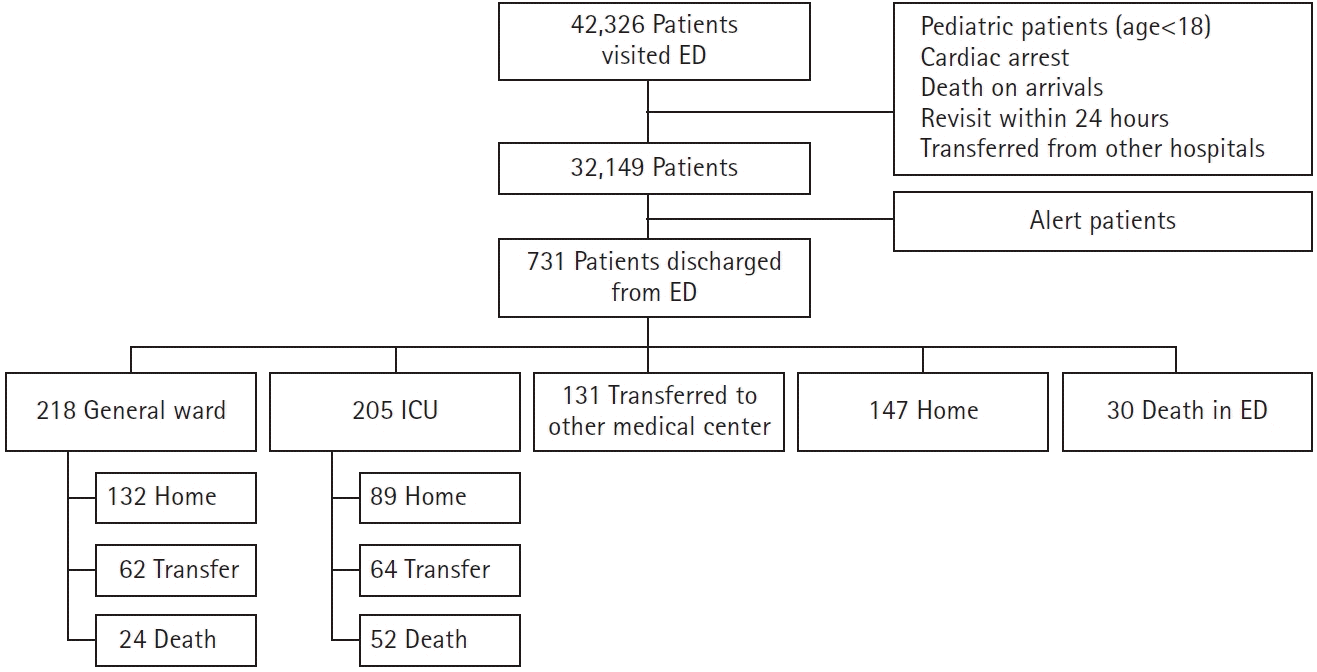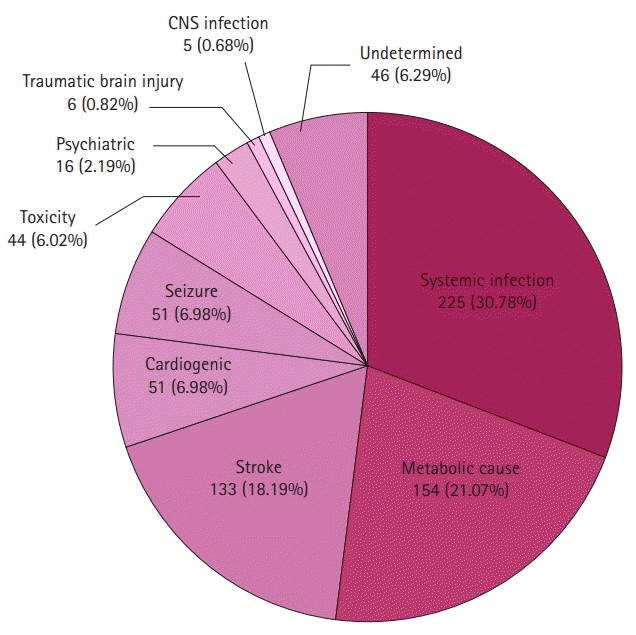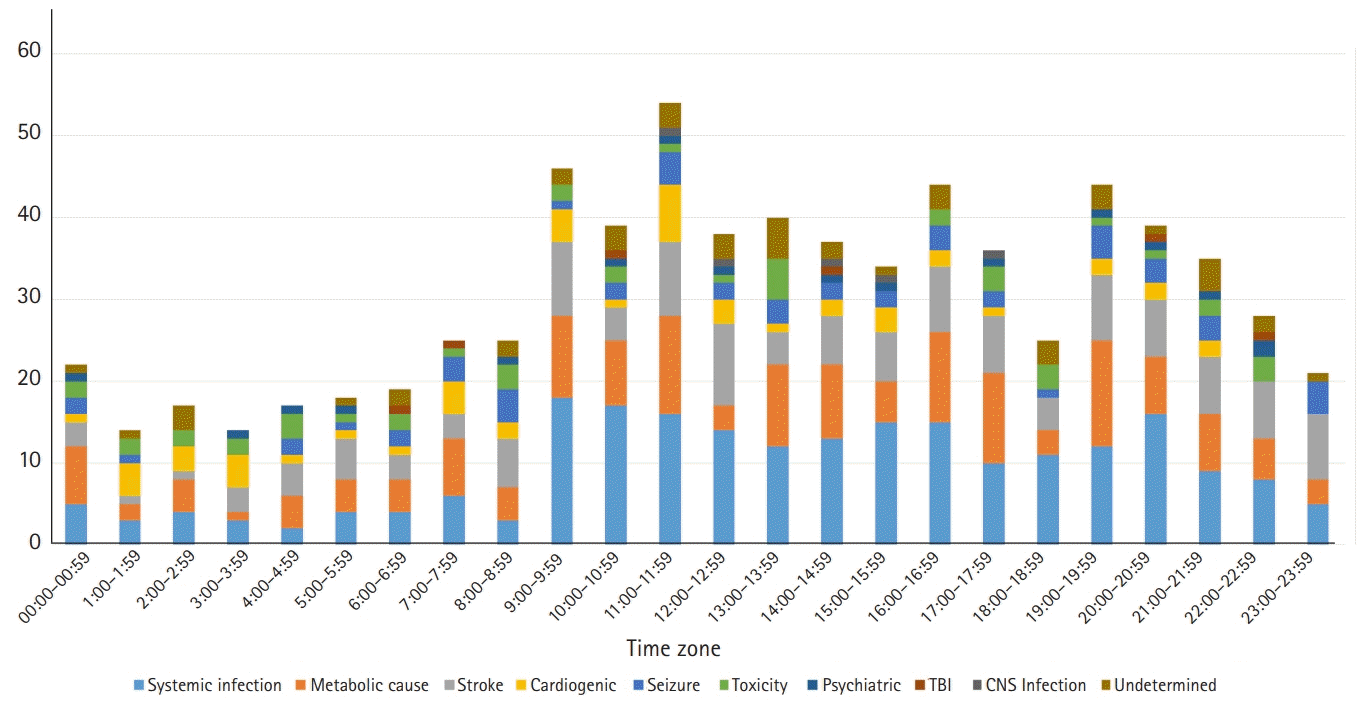Abstract
Background
New-onset altered level of consciousness (ALC) is a common condition in patients visiting the emergency department (ED). We evaluated the clinical characteristics, causes, and prognosis of adult patients presenting with ALC at an ED of a university hospital to determine the etiologies, outcomes, and destinations of these patients.
Methods
The medical records of patients with ALC who visited the ED of a university hospital from February 2019 to January 2020 were reviewed. The cause of ALC and its classification were carefully decided by agreement through a discussion among board-certified clinicians in emergency medicine, neurology, and internal medicine.
Results
Of the 731 patients with ALC in the ED, whose mean age was 68.81±16.40 years, most were in their 80s (198, 27.09%). The most common etiology of ALC was systemic infection (30.78%), followed by metabolic causes (21.07%) and stroke (18.19%). Extracerebral and intracerebral etiologies of ALC in the ED accounted for 51.85% and 26.68% of the cases, respectively. The overall mortality of ALC in the ED was 17.67%. The largest number of ALC cases of 443 patients, i.e., 60.6% of all ALC patients in the ED, visited within the time zone of 07:00–19:00.
New-onset altered level of consciousness (ALC) is a common condition in patients visiting the emergency department (ED). ALC is a state of altered attention or arousal, not caused by physiological drowsiness. It refers to any change in the patient’s consciousness level from the baseline and is related to neurological manifestations of not only neurological diseases but also general medical illnesses [1].
Several studies have evaluated the cause of ALC in the ED. ALC can be caused by various diseases of a wide range of urgency and severity and has been reported from 5% to 40% of the patients visiting the ED, depending on how the population was defined in those previous studies [2-5]. Kanich et al. [1] reported that the most common causes of ALC in the ED were neurological causes (28%), followed by intoxications (21%), traumas (21%), psychiatric causes (14%), and infections (10%). Völk et al. [4] reported that approximately a quarter of all ALC cases in the ED were attributable to cerebrovascular diseases (24%), followed by systemic infections (12%), epileptic seizures (12%), psychiatric disorders (8%), metabolic causes (7%), and intoxications (7%). A recent German study of coma patients in the ED showed that intracranial hemorrhages (22%), epileptic seizures (22%), intoxications (19%), cerebral infarctions (11%), and metabolic causes (6%) were the common causes of coma [5]. In a Turkish study involving 790 patients with ALC in the ED [6], the etiologies were neurological problems (71.6%), trauma (10.4%), metabolic causes (6.1%), cardio-pulmonary disorders (6.2%), systemic infections (3.8%), gynecologic and obstetric causes (0. 4%), and intoxications (1.5%).
Since ALC is a classic life-threatening condition, the patients are given priority and medical resources are intensively infused into the patients with ALC used in these cases. Nonetheless, ALC in the ED is an intricate challenge for clinicians because the presentation of ALC itself is not always typical, does not indicate a diagnosis, and can change rapidly. We evaluated the clinical characteristics, causes, and prognosis of adult patients presenting with ALC to an ED of a university hospital to determine the etiologies, outcomes, and the destinations of these patients. This is the first study to analyze the etiology of ALC in the EDs in the context of South Korea.
This is a retrospective study in which we reviewed the medical records of patients with ALC who visited the ED of a university hospital from February 2019 to January 2020 to find patients whose initial Glasgow Coma Scale (GCS) score was not 15 (15 being the perfect score, indicating fully awake). The GCS grader was the first doctor to examine the patient, and was either the chief resident in charge or a faculty member in emergency medicine. We reviewed the patients’ medical records from the time of entry to the ED to discharge from the hospital. Patients under the age of 18 years were excluded, as the causes of altered mental status in children are different from those in adults. Cases of ALC after cardiac arrest and ALC after visiting the ED were excluded from the analysis. In addition, all patients transferred from other hospitals were excluded in order to exclude patients with existing ALC, such as those with severe dementia, stoke, or psychiatric disorders. Revisit at more than 24 hours after discharge was considered a new visit.
Based on the medical records, the patients' age, sex, history, tentative diagnosis in the ED, treatment, destination from the ED and discharge were reviewed. The following evaluation reports were reviewed: vital sign records, physical examination, neurological examination, electrocardiogram, chest radiography, laboratory results, brain computed tomography, brain magnetic resonance imaging, cerebrospinal fluid (CSF) analysis, and electroencephalography. The cause of ALC and its classification were determined after discussion with the authors, who are board-certified clinicians in emergency medicine, neurology, and internal medicine. The reference point for determining the cause of ALC in this study was the time of discharge from the ED. Thus, the tentative cause of ALC in the ED could differ from the definitive diagnosis at discharge. In addition, during the review of the medical records, the authors assessed which work-up was decisive in reaching the diagnosis of the ALC in the ED.
Student t-test was used to compare the prognosis and destination from the ED. The statistical test was two-tailed, and P<0.05 was considered statistically significant. IBM SPSS ver. 22.0 (IBM Corp., Armonk, NY, USA) was used for analysis.
From February 2019 to January 2020, a total of 42,376 patients visited the ED. Pediatric patients (age <18 years) and cases of cardiac arrest, death on arrival, and revisit within 24 hours were excluded. A total of 32,149 patients were reviewed, resulting in 731 eligible patients with ALC in the ED, whose mean age was 68.81±16.40 years (427 females, 54.5%) (Table 1, Fig. 1). Most patients were in their 80s, accounting for 27.09% (n=198) of the patients with ALC in the ED. The combined number of patients in their 70s and 80s was 391, accounting for 53.49% of the study population (Table 1).
Thirty patients died in the ED without being admitted to the general ward or intensive care unit (ICU) or transferred to another hospital. The most common causes of the decease-in-ED were complications related to ALC, such as systemic infection followed by shock, metabolic causes resulting in cardiac arrest, and cardiac arrest due to arrhythmia. Additionally, in three cases, there were two or more causes of death aside from ALC, but this could not be specified. Only one stroke patient died and no patients with seizure or central nervous system (CNS) infection died in the ED.
All the 147 ALC patients sent home eventually recovered consciousness after arriving in the ED; 131 were transferred to another hospital for emergency surgery, lack of hospital rooms, or the guardian's demand. Of the 423 hospitalized patients, 218 were hospitalized in the general wards, and 205 in the ICU. Of the 205 in the ICU, 112 were admitted after emergency surgery (Fig. 1). Of the 218 patients hospitalized in the general ward, 132 were sent home; 62 transferred to other hospitals after acute management; and 24 (11.01%) died eventually. Of the 205 patients admitted to the ICU, 89 were sent home; 64 transferred to another hospital after acute management; and 52 (25.37%) died. Although there were no statistical differences in mortality between the etiologies of ALC in the ED, the mortality was higher in the ICU than in the general ward (25.37% vs. 11.01%, P=0.000).
The causes of ALC vary. The identified etiologies of ALC in the ED are listed in Table 2 and illustrated in Fig. 2. The authors classified the etiologies as follows: systemic infection, metabolic causes, stroke, cardiogenic causes, seizure, toxicity, psychiatric disorders, traumatic brain injury (TBI), CNS infection, and undetermined. The leading cause of ALC in the ED was systemic infection, which accounted for approximately 30% of the cases, namely sepsis, septic shock, and acute confusion caused by fever, where CNS infection was excluded through CSF analysis. The second main cause was metabolic cause (154, 21.07%), which can be diagnosed on the basis of a significant abnormality in blood test findings, such as hyponatremia, hypoglycemia, diabetic ketoacidosis, hepatic encephalopathy, uremic encephalopathy, posterior reversible encephalopathy syndrome, and hyperammonemia. The third main cause was stroke (133, 18.19%), diagnosed when the acute CNS symptoms were compatible with the brain lesions found on neuroimaging. There were 51 patients (6.98%) developed ALC because of heart problems, such as sick sinus syndrome, ventricular tachycardia, paroxysmal supraventricular tachycardia, and myocardial infarction. Regardless of the presence of epilepsy, 51 patients (6.98%) developed ALC because of seizures. This group included patients with epileptic seizure as well as psychogenic non-epileptic seizure. Further, 44 (6.02%) and 16 (2.19%) patients developed ALC from toxic agents and psychiatric disorders, respectively. The “toxic agents” were sedatives, pesticides, chemical agents, anaphylaxis, and adverse effect of medications. In six patients (0.82%), ALC was caused by TBI, including two cases of concussion. There were five cases of CNS infection, three of which were viral, one bacterial, and one fungal. Despite 1 or 2 days of intensive evaluation in the ED, the cause of ALC remained undetermined in 46 patients.
The patient configuration by time zone is shown in Table 3 and illustrated in Fig. 3. In the time zones, the largest number of patients with ALC visited the ED between 11:00 and 12:00. Three hundred thirty-two (45.42%) patients with ALC visited the ED during the 8-hour period between 09:00 and 17:00, the working time of the outpatient clinic. Throughout this period, systemic infection was the most common etiology. The time zone with the highest number of patients with ALC due to systemic infection was from 09:00 to 10:00, and due to metabolic cause was between 19:00 and 20:00. During the daytime (07:00–19:00), 443 patients with ALC visited the ED, accounting for 60.6% of all patients with ALC in the ED.
This is the first study to analyze the etiology of ALC in ED in South Korea. ALC is a manifestation of extensive medical problems, and it is not easy to accurately define ALC. In the real world, various symptoms, such as confusion, disorientation, hallucination, psychosis, lethargy, and infrequent behavior are called ALC. Accordingly, extensive history taking, readymade pathways, and rapid and appropriate actions are needed to assess ALC in the ED. This study is significant as patients who visit the ED for ALC were analyzed in detail by etiology and time zone, and the findings can be used as fundamental data in the EDs. All the patients who were not alert when entering the ED were included in the analysis. Not only neurological, but also systemic critical illnesses should be considered in the management of patients with ALC in the ED.
The classifications of the etiologies of ALC in the ED in previous studies varied [1-8]. For example, a previous study included all patients with GCS <15, Mini-Mental State Examination <24, disorientation, hallucinations, confusion, or abnormal behavior [1], whereas another study evaluated all patients in the ED with "sudden onset unconsciousness" as the chief complaint [4]. There was a cross-sectional study that evaluated patients with delirium [2], and another study included only comatose patients [5]. Nonetheless, there is a general trend in classification: systemic infections, metabolic causes, and brain disorders per se. Although the cause (whether infection, metabolic, or other causes) may vary depending on the researcher's opinion, it does not mean that the classification of cause is confusing. In this study, we organized a research team of board-certified clinicians in ED-related fields, including emergency medicine, internal medicine, and neurology. For example, there was a case in which acute renal failure was caused by drugs used to treat pneumonia, and we regarded it as a case of ALC due to metabolic cause. The classification of etiologies and causes was made by agreement through sufficient discussions to ensure the validity of this study.
In previous studies, neurological problems (such as seizure and CNS infection) or stroke was reported as the leading cause of ALC in the ED [1,3,4,6,8], accounting for at least 28% [1] to 38% of the cases [4]. In our study, however, the two most common etiologies, systemic infection and metabolic cause, were extracerebral and accounted for more than half (51.85%). Nonetheless, significant acute cerebral pathologies cannot be excluded. There were 195 patients with acute intracerebral etiologies (i.e., stroke, seizure, CNS infection, and TBI)—26.68% of all ALC cases in the ED. The characteristics of patients with ALC visiting the ED may vary depending on various factors, such as regional or demographic background, location of the hospital, and national health care system. It should be noted, nonetheless, that this study demonstrated the importance of extra-cerebral etiologies in treating patients with ALC in the ED.
The composition of the patients or causes may change depending on the season or period. The majority of the patients tended to visit the ED mainly during the day. This study alone could not find the cause of the changes in patient composition over time. We only conjecture that patients with ALC tend to be referred from primary healthcare clinics, especially in cases of infection in which the doctor is the first to identify the signs, such as fever. We found that the combination of etiologies varied with the time zone, however, what we need to note is that patients categorized under “undetermined” was steady across all the time zones. There were 46 patients with undetermined etiology, accounting for 6.29% of all ALC cases in the ED. In a recent study of patients with seizures in the ED [7], in 65.95%, the cause could not be determined until discharge. In practice, the cause of ALC diagnosed in the ED is not the definitive diagnosis. In addition, even if the patient is unconscious, a single seizure cannot be diagnosed as epilepsy when the evaluation does not yield any abnormal results. In this study, we found such an example wherein a patient diagnosed with stroke in the ED was actually found to have multiple sclerosis after sufficient examination. Indeed, the definitive diagnosis of a patient with ALC could differ from the tentative diagnosis in the ED. What we should do in ED is not to make a definitive diagnosis, but to take an appropriate and immediate action.
The overall mortality of ALC in the ED managed in our hospital was 17.67%. Although the 30 deceased-in-ED may have been unavoidable, it suggests that patient flow and shortage of hospital beds should be addressed. This study reported a higher mortality in patients with ALC in the ICU than in the general ward. The reason for being hospitalized in the ICU could not be analyzed for all patients; in addition, there was no difference in the causes of ALC between the general ward and ICU. We suppose that the severity of disease rather than the classification of the causes of ALC would affect the mortality rate of ALC in the ED.
There are several limitations. First, as this was a single-center retrospective study, selection bias could not be avoided. Second, since the scope of this study was limited to clinical practice in the ED, whether the diagnosis was changed after hospitalization or at the outpatient clinic thereafter was not determined. The issue in this study was the tentative diagnosis of ALC in the ED; subsequent studies could analyze the definitive diagnoses.
ALC has a wide variety of causes; it can take a long time to achieve a definitive diagnosis, some diagnostic approaches require additional evaluation that is not available in the ED, and two or more causes can occasionally be present concomitantly. These obstacles make it challenging to study ALC in the ED; however, this is why further study and analysis are needed.
Notes
REFERENCES
1. Kanich W, Brady WJ, Huff JS, Perron AD, Holstege C, Lindbeck G, et al. Altered mental status: evaluation and etiology in the ED. Am J Emerg Med. 2002; 20:613–7.

2. Naughton BJ, Moran MB, Kadah H, Heman-Ackah Y, Longano J. Delirium and other cognitive impairment in older adults in an emergency department. Ann Emerg Med. 1995; 25:751–5.

3. Smith AT, Han JH. Altered mental status in the emergency department. Semin Neurol. 2019; 39:5–19.

4. Völk S, Koedel U, Pfister HW, Schwankhart R, Op den Winkel M, Mühlbauer K, Klein M. Impaired consciousness in the emergency department. Eur Neurol. 2018; 80:179–86.

5. Schmidt WU, Ploner CJ, Lutz M, Möckel M, Lindner T, Braun M. Causes of brain dysfunction in acute coma: a cohort study of 1027 patients in the emergency department. Scand J Trauma Resusc Emerg Med. 2019; 27:101.

6. Kekec Z, Senol V, Koc F, Seydaoglu G. Analysis of altered mental status in Turkey. Int J Neurosci. 2008; 118:609–17.

Fig. 1.
Enrollment, destinations from emergency department (ED), and results of patients with altered level of consciousness (ALC). ICU, intensive care unit.

Fig. 2.
Causes of altered level of consciousness in the emergency department. CNS, central nervous system.

Table 1.
Demographic data of the patients with ALC in the ED
| Variable | No. (%) (n=731) |
|---|---|
| Female sex | 427 (54.5) |
| Age (yr) | |
| ≤29 | 20 (2.74) |
| 30–39 | 37 (5.06) |
| 40–49 | 35 (4.79) |
| 50–59 | 92 (12.59) |
| 60–69 | 127 (17.37) |
| 70–79 | 193 (26.40) |
| 80–89 | 198 (27.09) |
| ≥90 | 29 (23.97) |
Table 2.
The causes of ALC in the ED
Table 3.
Cause analysis of ALC in the ED by time zone




 PDF
PDF Citation
Citation Print
Print




 XML Download
XML Download